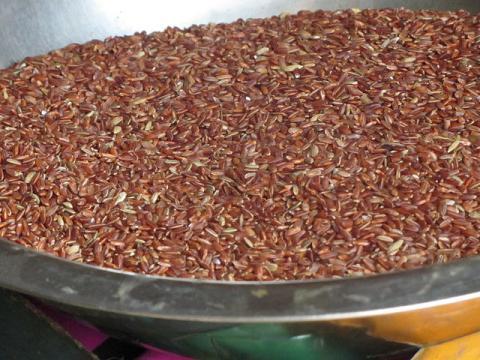
Red rice is a whole grain that gets it color from compounds called anthocyanins that are found in red vegetables like red cabbage and red onions.. It is found in the outer layer of the grain, known as bran, and is closely related to bioflavonoids. Red rice is also an effective antioxidant. It has been considered an exotic grain, especially in the United States, and is grown in several regions throughout the world. In southern France they grow a short-grain red rice that is similar to the Bhutanese or Himalayan red rice. Thai red rice is also known as cargo rice and is long-grain and is much like jasmine rice. These three varieties have an earth tone red color with a nutty flavor. California grows Colusari rice which is more burgundy in color. All red rice is prepared like brown rice: with a ratio of one cup of rice to two cups of liquid. It is a valuable grain used in Ayurveda and in holistic healing because of its high nutrient content and because it is a good source of fiber and iron.
Red rice is a healthy addition to the diet, containing vitamins, minerals, and other essential nutrients. Here are 5 reasons to get more red rice in your diet!
1. The high fiber content of red rice helps to maintain the health of the lower digestive tract. It also reduces the incidence of heart disease by reducing cholesterol levels. Red rice is very filling, which aids in weight reduction.
2. Red rice has a high iron content -- iron carries oxygen to red blood cells and thus is essential to their development. This is also conducive to a healthy circulatory system.
3. The antioxidant value of red rice reduces stress to cells and the development of deformed cells that can become cancer cells. It diminishes the free radicals that can form in the body. This also relaxes the system, enabling the body to function normally and reduce the risk of disease.
4. High in calcium, red rice contributes to a healthy skeletal system and dental health. It strengthens the bones, reducing the risk of osteoporosis and arthritis.
5. Red rice is a valuable grain containing manganese that strengthens the metabolism, magnesium that lowers blood pressure, and selenium that helps the body fight infection. It is also effective in reducing the complications of Type-2 diabetes. It has a low glycemic index that helps to control and balance blood sugar levels. Other factors in the healing effects of red rice are that it helps to reduce arterial plaque, lowering the risk of cardiovascular disease.
Red rice can be found in many health food stores, as well as in Indian and Asian food stores. It is usually more expensive than brown rice but adds its own unique flavor, texture, and color to many recipes.
Photo by Sengai Podhuvan - Own work, CC BY-SA 3.0, Link








